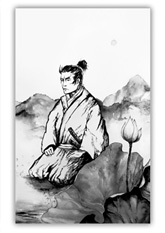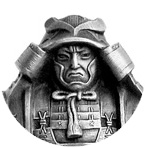The Samurai and Zen Buddhism
bushido. The way of the samurai
-

In gunbaisha schools, the samurai had to memorize hundreds of meaningless items and words to acquire the abstract ability of focusing and unfocusing their minds. This is illustrated in yet another story of a samurai’s super-human feats. A Zen disciple stopped at a goldfish vendor to watch the fish swimming in a tank. He was fascinated, so the vendor offered to give him the fish for free if he counted how many there were without touching them. The samurai looked, concentrated, and proclaimed that there were 386. Stunned, the vendor handed the samurai the tank full of fish, and he released them into the sea...
“If you are unable to find the truth right where you are, where else do you expect to find it?”
― DōgenChristians divide the world into black and white, the realm of Satan and the realm of God. But for Buddhists, “the whole world is an illusion”; all the good and bad in the world are you, or, more accurately, reflections of how you view yourself. There is neither evil nor goodness, there is neither life nor death, and these are just different sides of the same illusion. A case in point is the story of a Chinese Emperor’s encounter with Bodhidharma.1 The Emperor supported the spread of Buddhist teachings by building many Buddhist temples and monasteries. When he encountered the priest he expected praise from the old man. However, he received none. Then he bluntly asked what the monk thought of his deeds, to which the monk responded, “Nothing.” The emperor was outraged, and the only thing keeping him from executing the monk was his fear of being criticized by the public. No one really knows whether he understood the message the monk was sending with his response, which is the essence of Buddhism, nothingness.
Walking along the thin string of life with “reality” and “common sense” on one side the “unknown” on the other, people are constantly struggling for balance. To avoid falling, they fearfully try to juggle the sparkling fetishes they create in their minds and become entranced by their magic. But Buddhists understand that the string doesn’t exist. To renounce the ego and sever ties with environment, people must enter a meditative trance, essentially climbing a metaphoric stairway that leads to Nirvana.
To facilitate Enlightenment, a person should always try to improve their karma in future lives. In general terms, karma according to Buddhism means that physical death does not mean an end to life, but allows for a new birth. This new birth is directly linked to the deeds of a person’s previous life. Wicked deeds create bad karma and pave the way for a life full of suffering. In contrast, good deeds bear good fruit. Therefore, a person must strive for goodness and self-improvement.
~A. R. Berg, Ascension

Painting "Renunciation" by Tatiana Berg
“Do not be concerned with the faults of other persons. Do not see others' faults with a hateful mind. There is an old saying that if you stop seeing others' faults, then naturally seniors and venerated and juniors are revered. Do not imitate others' faults; just cultivate virtue. Buddha prohibited unwholesome actions, but did not tell us to hate those who practice unwholesome actions.”
~ Zen Master Dōgen
Sternness and asceticism were the norm. The samurai did not permit entertainment or emotions to taint their bodies and spirits. Nevertheless, many still enjoyed things like sake and tobacco and playing games of risk. Zen teacher Takuan Soho had this to say, “It would not be surprising if the nobility and the samurai alike, when they realized that this floating world is but a dream, lit lamps and amused themselves throughout the night.” But these were of low-priority because, “He who is great is cruel to his second-rate virtues and judgements.”
~A. R. Berg, Ascension
A Zen teacher once asked his pupil, “Do you see yonder a pennant fluttering in the wind? What is moving? The wind, the pennant or…”
The disciple responded, “It is only your consciousness that is moving… Though it’s also immovable… eternal… infinite.”The samurai lived mostly in their inner worlds, their sources of strength. Their subconscious was where they rested and took refuge. By plunging into the mystic void they could create any image or illusion in their mind’s eye. They could travel to their childhood, watch the sun setting on a snowy mountain peak, or listen to the ocean waves singing.
Harnessing the ability to control their thinking process required continuous training in special clan-run schools and monasteries where asceticism and tough discipline reigned. It was effective. It made the samurai brave, extremely disciplined and merciless with themselves.
They would sit in rows – still, backs straight, legs tucked under – meditating for many hours, sometimes days, sinking deeper and deeper into their worlds. Their teachers would walk around and lash them on their backs with bamboo sticks if they fell asleep. Other times, the samurai would deliberately move so that the blow would help relax their numbing back muscles.
The goal of this exhausting training was to expel laziness from the body, master it and create an ‘iron will.’ And the samurai succeeded.We see this in the tale of the samurai who challenged a renowned Zen monk to a spiritual duel. The challenge was to see who could stand motionless the longest. After five days, the monk collapsed and the samurai was still on his feet. This continuous psychological training gave the samurai the power to concentrate on a single thought as well as discard all other thoughts completely, stopping the stream of ideas and images.
“If you want to travel the Way of Buddhas and Zen masters, then expect nothing, seek nothing, and grasp nothing.”
― Dōgen Zenji
Enso: Zen circleThe samurai used their minds to control their bodies and perceive their slightest responses. Spirit separated from the body was free to wander in the mystic wilderness, or Great Void. The meditative voyage was the experience of detachment from worldly life – the experience of dying. The samurai were not afraid for they had meditated many times and had gained courage in the distracted solitude. ‘Real’ death differed in only one way: that the Golden Thread of Life was severed and the Soul did not return into its body. If necessary, well-trained samurai could willfully leave their bodies, cease breathing and stop the vital processes. Alternately, they could merely slow down the vital processes or speed them up, surging so many hormones into the bloodstream that they did not feel fatigue or pain. Achieving this state of simultaneous concentration and de-concentration was the foundation of the samurai’s martial philosophy.
“Spirit and body must be inseparable,” Bodhidharma said. The samurai’s body merged with spirit and its obedience to the mind’s will was instinctively right and therefore perfect.~A. R. Berg, Ascension

The samurai saw life and death in a really estranged way, like outside observers looking at a labyrinth of life from above. This idea was ingrained in their minds by Zen teachers. Various psychological technologies of shaping consciousness, practices in their daily lives and the gory reality of war developed in the samurai a balance between an adamant will to live and a cool contempt for life. Their motto: Live proudly and gloriously, as is proper for a Master of this life.
Back to the Blog
This article contains quotes from the Samurai Series by A. R. Berg

